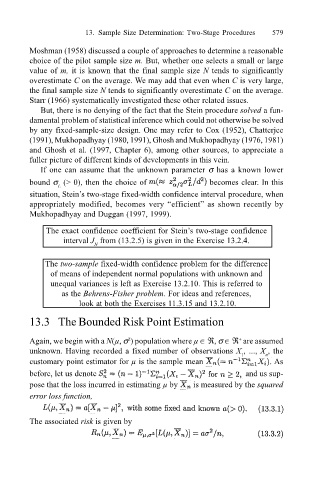Page 602 - Probability and Statistical Inference
P. 602
13. Sample Size Determination: Two-Stage Procedures 579
Moshman (1958) discussed a couple of approaches to determine a reasonable
choice of the pilot sample size m. But, whether one selects a small or large
value of m, it is known that the final sample size N tends to significantly
overestimate C on the average. We may add that even when C is very large,
the final sample size N tends to significantly overestimate C on the average.
Starr (1966) systematically investigated these other related issues.
But, there is no denying of the fact that the Stein procedure solved a fun-
damental problem of statistical inference which could not otherwise be solved
by any fixed-sample-size design. One may refer to Cox (1952), Chatterjee
(1991), Mukhopadhyay (1980, 1991), Ghosh and Mukhopadhyay (1976, 1981)
and Ghosh et al. (1997, Chapter 6), among other sources, to appreciate a
fuller picture of different kinds of developments in this vein.
If one can assume that the unknown parameter σ has a known lower
bound σ (> 0), then the choice of becomes clear. In this
L
situation, Steins two-stage fixed-width confidence interval procedure, when
appropriately modified, becomes very efficient as shown recently by
Mukhopadhyay and Duggan (1997, 1999).
The exact confidence coefficient for Steins two-stage confidence
interval J from (13.2.5) is given in the Exercise 13.2.4.
N
The two-sample fixed-width confidence problem for the difference
of means of independent normal populations with unknown and
unequal variances is left as Exercise 13.2.10. This is referred to
as the Behrens-Fisher problem. For ideas and references,
look at both the Exercises 11.3.15 and 13.2.10.
13.3 The Bounded Risk Point Estimation
Again, we begin with a N(µ, σ ) population where µ ∈ ℜ, σ ∈ ℜ are assumed
2
+
unknown. Having recorded a fixed number of observations X , ..., X , the
n
1
customary point estimator for µ is the sample mean As
before, let us denote and us sup-
pose that the loss incurred in estimating µ by is measured by the squared
error loss function,
The associated risk is given by

